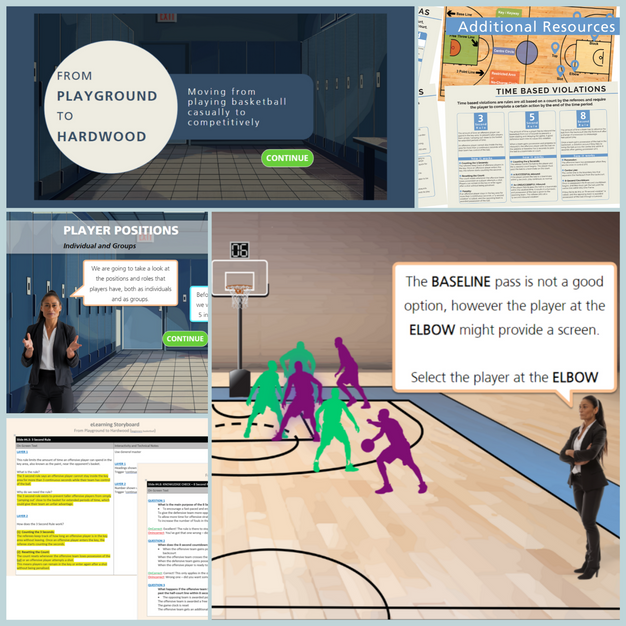"We can’t afford to learn the rules during a tournament"
This project was borne from the frustration of the coaching staff watching teams fail to meet their potential despite their individual skills, effort and desire.
Through consultation with the coaching staff, it was determined that a number of factors were contributing to players not understanding official rules, roles and in-game instruction.
With face-to-face training time being very limited, a program of eLearning materials were created for players to learn from in their own time.

Overview
These materials were developed with the intention of allowing players to become familiar with some of the more technical aspects of the game without taking away from precious team training sessions.
The project contains learning scenarios across a range of topics with knowledge checks as well as on-court simulations to apply the knowledge in a realistic situation. The project also contains several resource documents used for both completing activities and for later use.
Audience: High school students – 12-18 years with an interest in basketball, but no competition experience
Tools: Articulate Storyline, Adobe Illustrator, Adobe Photoshop, Midjourney
Process
The project was created using the following methodology:
- Learning Needs Assessment
- Action Mapping
- Text-Based Storyboard
- Asset Creation
- Prototype & Testing
- Final Project
Learning Needs Assessment
Discussions with the coaching staff quickly identified a few broad knowledge and skill gaps that were believed to be at the core of the problem – a lack of understanding of rules and instructions. These broad categories were then broken down into smaller key items.
Each of these key items was then analysed to understand the purpose of knowing them (to avoid wasting time on ‘nice to have’ knowledge) and to determine what factors are stopping the players from currently knowing and doing this.
This process allowed us to focus on the most important new information and in some cases correct misunderstandings.
Action Mapping
This project was well suited to the process of action mapping as it involved changing the way people do things – a performance problem. Keeping a focus on the actions we wanted to see led to practice activities being realistic simulations driving engagement and a better understanding.
Targeting these most essential skills led us to develop a succinct but thorough learning experience that replicates an in-person practice session.

Text-Based Storyboard
As this was a dialogue heavy project, it was crucial to have this planned thoroughly to ensure completeness and coherency.
The use of a text-based storyboard allowed for replicating elements across many different scenes and slides, with consistent behaviour to allow the learner to feel comfortable with the learning activity.
The document below is an extract of this, showing how dialog, interactions and elements are all considered and kept uniform.

Asset Creation
The simulation style required the use of scenes that would feel authentic to the learners. As such, the concept of being spoken to by coaches before running the activities on court was chosen as it mimics the actual behaviour in training sessions.
This therefore required assets that feel authentic. To get the required feeling, the simulation court was created in Adobe Illustrator and Photoshop to allow for the correct perspective of watching a session. Following this, characters, silhouettes, floors and backgrounds were developed by the use of AI image generation tool Midjourney.
In addition to the course activities there are also a number of reference resources that can be used in the completion of the course, but also as reference material going forward.





Prototype and Testing
A number of the components used in this course had been tested through other methods prior. This included Microsoft OneNote and Forms to provide information and to assess knowledge retention however as expected, it lacked authenticity and never truly connected with the learners.
The addition of simulations – which were built off actual real-life training activities – work to overcome these issues.
Final Project
The final course contains a combination of content and simulation to meet the needs of the learners, as identified by the coaching staff. The main goals for this project included:
- Allow players with little background in organised competitive basketball to become familiar with some common rules and instructions
- e accessible anytime by the players, with feedback mechanism built in
- Provide resources for reference even after completing the course
- Free up team training time to concentrate on activities that require in-person contact
• Reduce errors made by players that come from misunderstanding or a communication breakdown
There is also scope for extending the project’s application to more advanced players with more advanced content built on the existing assets and simulation activities. Some of the uses being considered are to teach and learn defensive schemes, offensive plays, and threat recognition.
In the end, this project resulted in a succinct learning resource that targets its learners with engaging learning through simulation.